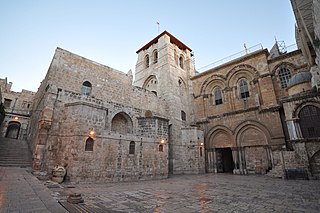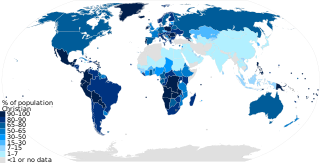The Apostles' Creed, sometimes titled the Apostolic Creed or the Symbol of the Apostles, is a Christian creed or "symbol of faith".

Christianity is an Abrahamic monotheistic religion based on the life and teachings of Jesus. It is the world's largest and most widespread religion with roughly 2.4 billion followers, comprising around 31.2% of the world population. Its adherents, known as Christians, are estimated to make up a majority of the population in 157 countries and territories. Christians believe that Jesus is the Son of God, whose coming as the Messiah was prophesied in the Hebrew Bible and chronicled in the New Testament.

Christendom historically refers to the Christian states, Christian empires, Christian-majority countries and the countries in which Christianity dominates, prevails, or that it is culturally or historically intertwined with.

The Nicene Creed also called the Creed of Constantinople is the defining statement of belief of Nicene or mainstream Christianity and in those Christian denominations that adhere to it. The original Nicene Creed was first adopted at the First Council of Nicaea in 325. In 381, it was amended at the First Council of Constantinople. The amended form is also referred to as the Nicene Creed, or the Niceno-Constantinopolitan Creed for disambiguation.

Western Christianity is one of two subdivisions of Christianity. Western Christianity is composed of the Latin Church and Western Protestantism, together with their offshoots such as the Old Catholic Church, Independent Catholicism and Restorationism.

In Roman religion, the genius is the individual instance of a general divine nature that is present in every individual person, place, or thing. Much like a guardian angel, the genius would follow each man from the hour of his birth until the day he died. For women, it was the Juno spirit that would accompany each of them.
The Takbir is the name for the Arabic phrase Allāhu ʾakbaru.

Annuit cœptis is one of two mottos on the reverse side of the Great Seal of the United States. The literal translation is "[He] favors [our] undertakings", from Latin annuo, and coeptum. Because of its context as a caption above the Eye of Providence, the standard translations are "Providence favors our undertakings" and "Providence has favored our undertakings".
The East–West Schism, also known as the Great Schism or Schism of 1054, is the ongoing break of communion between the Roman Catholic and Eastern Orthodox churches since 1054. A series of ecclesiastical differences and theological disputes between the Greek East and Latin West preceded the formal split that occurred in 1054. Prominent among these were the procession of the Holy Spirit (Filioque), whether leavened or unleavened bread should be used in the Eucharist, the Pope's claim to universal jurisdiction, and the place of the See of Constantinople in relation to the pentarchy.

Hallelujah is an interjection from the Hebrew language, used as an expression of gratitude to God. The term is used 24 times in the Hebrew Bible, twice in deuterocanonical books, and four times in the Christian Book of Revelation.

"Gloria in excelsis Deo" is a Christian hymn known also as the Greater Doxology and the Angelic Hymn/Hymn of the Angels. The name is often abbreviated to Gloria in Excelsis or simply Gloria.

Sol Invictus was the official sun god of the late Roman Empire and a later version of the god Sol. The emperor Aurelian revived his cult in AD 274 and promoted Sol Invictus as the chief god of the empire. The main festival dedicated to him was the Dies Natalis Solis Invicti on 25 December, the date of the winter solstice in the Roman calendar. From Aurelian onward, Sol was of supreme importance, and often appeared on imperial coinage. He was often shown wearing a sun crown and driving a horse-drawn chariot through the sky. His prominence lasted until the emperor Constantine I established Christianity as the Imperial religion. The last inscription referring to Sol Invictus dates to AD 387, although there were enough devotees in the fifth century that the Christian theologian Augustine found it necessary to preach against them.

Interpretatio graeca, or "interpretation by means of Greek [models]", refers to the tendency of the ancient Greeks to identify foreign deities with their own gods. It is a discourse used to interpret or attempt to understand the mythology and religion of other cultures; a comparative methodology using ancient Greek religious concepts and practices, deities, and myths, equivalencies, and shared characteristics.

The Temple of Jupiter Optimus Maximus, also known as the Temple of Jupiter Capitolinus was the most important temple in Ancient Rome, located on the Capitoline Hill. It was surrounded by the Area Capitolina, a precinct where numerous shrines, altars, statues and victory trophies were displayed.

Konrad Mutian was a German Renaissance humanist.

Soli Deo gloria is a Latin term for Glory to God alone. It has been used by artists like Johann Sebastian Bach, George Frideric Handel, and Christoph Graupner to signify that the work was produced for the sake of praising God. The phrase has become one of the five solae propounded to summarise the Reformers' basic beliefs during the Protestant Reformation.

In the history of Christianity, the first seven ecumenical councils include the following: the First Council of Nicaea in 325, the First Council of Constantinople in 381, the Council of Ephesus in 431, the Council of Chalcedon in 451, the Second Council of Constantinople in 553, the Third Council of Constantinople from 680–681 and finally, the Second Council of Nicaea in 787. All of the seven councils were convened in what is now the country of Turkey.

The Byzantine Empire, also referred to as the Eastern Roman Empire, was the continuation of the Roman Empire centered in Constantinople during Late Antiquity and the Middle Ages. The eastern half of the Empire survived the conditions that caused the fall of the West in the 5th century AD, and continued to exist until the fall of Constantinople to the Ottoman Empire in 1453. During most of its existence, the empire remained the most powerful economic, cultural, and military force in the Mediterranean world. The term "Byzantine Empire" was only coined following the empire's demise; its citizens referred to the polity as the "Roman Empire" and to themselves as "Romans". Due to the imperial seat's move from Rome to Byzantium, the adoption of state Christianity, and the predominance of Greek instead of Latin, modern historians continue to make a distinction between the earlier "Roman Empire" and the later "Byzantine Empire".

Christianity in late antiquity traces Christianity during the Christian Roman Empire — the period from the rise of Christianity under Emperor Constantine, until the fall of the Western Roman Empire. The end-date of this period varies because the transition to the sub-Roman period occurred gradually and at different times in different areas. One may generally date late ancient Christianity as lasting to the late 6th century and the re-conquests under Justinian of the Byzantine Empire, though a more traditional end-date is 476, the year in which Odoacer deposed Romulus Augustus, traditionally considered the last western emperor.

St Mary's Catholic Church in Hokitika, New Zealand, is a Roman Catholic church. It is a landmark on the country's West Coast.















